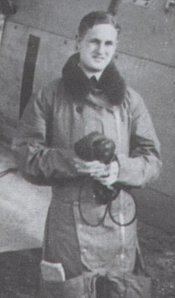Allegiance United Kingdom Name Donald Garland Rank Flying officer Battles/wars World War II | Battles and wars World War II Years of service 1937-40 † Role Armed force officer | |
 | ||
Born 28 June 1918Ballincor, Ireland ( 1918-06-28 ) Place of burial Heverlee Commonwealth War Graves Commission Cemetery, Leuven, Belgium | ||
Donald Edward Garland VC (28 June 1918 – 12 May 1940) was an Irish recipient of the Victoria Cross, the highest and most prestigious award for gallantry in the face of the enemy that can be awarded to British and Commonwealth forces.
Contents
Early life
Born in Ballinacor, County Wicklow, Garland was a pupil at Cardinal Vaughan Memorial School, Holland Park, London from 1929 to 1935, and left with a good all-round School Certificate.
After spending some time at an insurance office, he joined the RAF on a short-term commission. Mgr. Canon J. Vance, who became headmaster of Cardinal Vaughan School in 1928: "In those days I questioned young men closely before recommending their applications for short-term commissions because of a lurking fear that they might be forced to start life again at an awkward age, for Donald I had no misgivings whatever. He could start his life again at any time and was bound to succeed because of his independence and of his resourcefulness. I salute Garland's great heroism"
Victoria Cross
Garland was 21 years old, and a Flying Officer in No. 12 Squadron, Royal Air Force during World War II, when the following deed took place for which he was awarded the VC.
On 12 May 1940, over the Albert Canal, Belgium, two bridges, Veldwezelt and Vroenhoven, were being used by the invading army, with protection from fighter aircraft, anti-aircraft and machine-guns. The RAF was ordered to demolish one of these vital bridges, and five Fairey Battle bombers were despatched with Flying Officer Garland leading the attack. They met an inferno of anti-aircraft fire, and the bridge was hit but not put out of commission. Garland and his navigator, Sergeant Thomas Gray, attacked the bridge at Veldwezelt. They died either crashing in the village of Lanaken, or in the hospital in Maastricht, Netherlands. Only one bomber managed to return to base. Sergeant Gray was also awarded the VC for this action in a joint citation with Garland.
Garland is buried at the Heverlee War Cemetery near Leuven, Belgium.
Both Garland and Gray were awarded the Victoria Cross posthumously. Leading Aircraftman Reynolds, the third member of the crew, did not receive a medal because he was not in a "decision making" position. Garland's Victoria Cross is displayed at the Royal Air Force Museum, Hendon, England.
He had three brothers, all of whom served with the RAF and also died on service:
Victoria Cross citation
The announcement and accompanying citation for the decoration was published in supplement to the London Gazette on 11 June 1940, reading
'Air Office, 11th June, 1940
The KING has been graciously pleased to confer the VICTORIA CROSS on the undermentioned officer and non-commissioned officer in recognition of most conspicuous bravery :-
Flying Officer Donald Edward Garland (40105)
563627 Sergeant Thomas Gray
Flying Officer Garland was the pilot and Sergeant Gray was the observer of the leading aircraft of a formation of five aircraft that attacked a bridge over the Albert Canal which had not been destroyed and was allowing the enemy to advance into Belgium. All the aircrews of the squadron concerned volunteered for the operation, and, after five crews had been selected by drawing lots, the attack was delivered at low altitude against this vital target. Orders were issued that this bridge was to be destroyed at all costs. As had been expected, exceptionally intense machine-gun and anti-aircraft fire were encountered. Moreover, the bridge area was heavily protected by enemy fighters. In spite of this, the formation successfully delivered a dive-bombing attack from the lowest practicable altitude. British fighters in the vicinity reported that the target was obscured by the bombs bursting on it and near it. Only one of the five aircraft concerned returned from this mission. The pilot of this aircraft reports that besides being subjected to extremely heavy anti-aircraft fire, through which they dived to attack the objective, our aircraft were also attacked by a large number of enemy fighters after they had released their bombs on the target. Much of the success of this vital operation must be attributed to the formation leader, Flying Officer Garland, and to the coolness and resource of Sergeant Gray, who in most difficult conditions navigated Flying Officer Garland's aircraft in such a manner that the whole formation was able successfully to attack the target in spite of subsequent heavy losses. Flying Officer Garland and Sergeant Gray did not return.
Memorials
A Vickers VC-10 Serial 'XR807' of 101 Squadron was named 'Donald Garland VC & Thomas Gray VC'.
During 2005, to mark its 90th anniversary, No.12 Squadron RAF flew a Tornado GR4 with Flying Officer Garland's and Sgt Gray's name painted under the cockpit as a mark of respect.
There is a monument on the bridge to the operation.
On the day of the attack on the bridge, Garland and his crew flew from the grass airfield near the village of Amifontaine, France, where 12 Squadron had been based since December 1939, No memorial to the airfield, and to the men who flew from it, has been reported to exist in the area.
